
2. SUMMARIES OF REMARKS, PRESENTATIONS, AND SITE VISIT
Mr. Masahide Shima (ECCJ Managing Director) opened the workshop. In his opening remark, he expressed great pleasure in welcoming all the participants. He pointed out the objectives and encouraged everyone to participate actively in the discussion and to come up with actionable outputs of the ECAP 17

Opening remark by
Mr. Shima from ECCJ
Mr. Rizky Aditya Putra (representative of ACE) warmly welcomed all the delegates to the workshop. He expressed his gratitude to METI and ECCJ for the continuous support given to ACE and AMSs. He emphasized the importance of building EE&C and new initiatives of ZEB as a new category for the AEA in 2019. He also wished a fruitful workshop to the participants.

Opening remark by
Mr. Putra from ACE
Keynote Lecture
Mr. Tomoaki Hara (Deputy Director, International Affairs Office, Energy Efficiency and Renewable Energy Department, Agency for National Resources and Energy (ANRE), METI) delivered his lecture on EE&C policies in Japan. The comprehensive presentation introduced the “EE&C policy framework,” “measures and energy–saving potential by sector,” “comparative overview of the EC Act and the building energy–efficiency act,” and “phased mandatory compliance with the residence and building EE&C standards.” His presentation highlighted the basic energy plan and future investment strategy in the short– to mid-term to further promote the energy conservation of residences and buildings. He also stated that collaboration between related ministries and agencies is important because both EE&C and the construction sector are correlated for building EE&C.
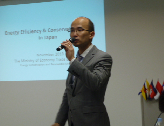
Keynote lecture by
Mr. Hara from METI
Lectures by Japanese Experts
Mr. Yoshitaka Ushio (ECCJ senior advisor) presented the ongoing scenario with respect to the “Energy Conservation Benchmark System in Japan.” The presentation reviewed his previous year’s lecture on the same topic, reflecting on the changes since then. According to Mr. Ushio, because it is difficult to maintain a 1% reduction in energy consumption intensity on a yearly average, the “benchmark system” is studied and introduced as a new assessment index.
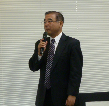
Lecture by Mr. Ushio
In industrial sectors where energy conservation measures are well implemented, achieving the “benchmark index” has become difficult. He also described the expansion of the “benchmark system” to the commercial sector. In the first phase, the application was expanded to six business types of the commercial sector (e.g., stores, rental offices, and shopping centers). In the second phase, the application was further expanded to restaurants, schools, hospitals, and others. AMSs are expected to learn from the Japanese introduction process and customize in conformance with the situation in their respective countries.
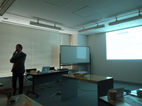
Lecture by Mr. Yamamoto
Mr. Katsuhiko Yamamoto (Manager, Business Alliance Support Center, ECCJ/Jase-W) delivered his lecture on “ZEB Family Concept and International Standardization.” He stated the following: (i) action for standardization of the ZEB family concept in the international arena and (ii) advice to the AMSs to incorporate ZEB–ready effective evaluation criteria into the AEA. He requested AMSs’ support in the process of the international standardization of the ZEBfamily concept to ISO by asking AMSs to become participating members to vote for Japan. Regarding case (ii) above, he mentioned that it should have six important points at every phase of the ZEB building and future upgrade plans.
Mr. Kunio Ito (Manager Consumer division, Sustainable open Innovation Initiative (SII)) and Mr. Mitsuru Deguchi (Nomura Research Institute Senior Consultant) gave their lecture on “Design Guidelines and Pamphlets for Planning and Designing of Zero–Energy Buildings.” They explained “definition of ZEBs,” “design guidelines and pamphlets of ZEB,” “typical examples of ZEBs for each building use,” and “aiming for realization and dissemination of ZEBs.” Three points were included in Japan’s first ZEB realization manual targeting ZEB–ready buildings: “provided with explanations using calculation programs that are compliant with the EE&C standards,” “includes renewable energies and points requiring care during operation,” and “includes actual design examples.”
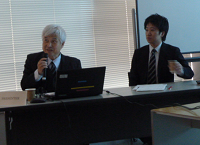
Lecture by Mr. Ito and Mr. Deguchi
Confirmation of the energy conservation overall picture, increased amount rate of estimated costs for the overall building (approximately 112%), and some technical points to be noted were pointed out. The speakers also mentioned the merits of ZEB ready other than EE&C–related aspects; for example, it has merits in the field of the business continuity program (BCP) and improvement in intellectual productivity because of the better quality of life by ZEB–ready buildings.
Mr. Yasushi Tanaka (ECCJ Senior General Manager, International Collaboration Center) delivered his lecture on “ZEB–Related Best Practices in Japan from ECCJ’s Energy Conservation Grand Prize Award.” He explained Japan’s strategic energy plan of the ZEB roadmap and the current situation of existing buildings and recognition of problems. In his introduction of ZEB–related best practices, three characteristic cases were described.

Lecture by Mr. Tanaka
The first example was the comparison of office buildings in a large-scale new construction building and in a small- to medium-scale retrofitted building. The second example was the ZEB-oriented renewal of equipment at the welfare facilities for elderly people. The third example was the realization of ZEB at a golf course. These effective studies could be referred to AMSs in the near future.
Site Visit (Shin Nippon Air Technologies Co., Ltd.–SNK Engineering Center)
A one-day tour was arranged for the participants.
SNK Engineering Center of Shin Nippon Air Technologies Co., Ltd.
It is certified as five stars (highest rank) by the BELS metrics (Building-Housing Energy-efficiency Labeling System). The building includes a wide variety of unique EE&C technologies achieving ZEB ready as an existing building. The building achieved 53% of the energy reduction rate against the ZEB operational criteria rather than the design criteria specified by the standard of “The Society of Heating Air Conditioning and Sanitary Engineers of Japan (SHASE).”
The key words for ZEB–ready technologies were as follows:
(1) Highly efficient equipment: multi-air conditioner, heat pump chillers, pump controllers.
(2) Air conditioning system: ceiling perforated plate air conditioning systems, pneumatic ceiling radiation air conditioning, active swing, antibacterial air conditioners.
(3) Others: dimming-toning LED lighting, double glazing, solar photovoltaics, vertical louvers rain capture, photocatalytic deodorization blinds, running water generating automatic-type faucets, etc.

Shin Nippon Air Technologies Co., Ltd.–SNK (Shin Nippon Kutyou) Engineering Center in Yokohama City
Site Visit (Earth Building Tachikawa of Tokyo Gas Co., Ltd.)
It is certified as S (highest rank) by the CASBEE metrics (Comprehensive Assessment System for Built Environment Efficiency) for new construction and four stars by BELS. The building is designed to utilize natural energy to a maximum extent in addition to existing EE&C technologies, while improving the intellectual productivity of workers and business continuity in case of disaster. This building was an extremely practical and very helpful example for AMSs because it is an environment– and human-friendly building that is reliable and resilient.
The key words for ZEB–ready technologies were as follows:
(1) Energy generation and cycle system
The water heated by the solar heat collector is converted to chilled water using the natural chiller in the summer and utilized in the heat exchanger for heating in the winter for supplying the air conditioners. By using it in the desiccant air conditioner in the summer as well, this system utilizes solar heat to the maximum.
(2) Optimal control of the gas co–generation system (Genelight)
Trends in heat and electric power demands are predicted, and calculation of the supply is made to meet the demand at a minimum cost. Even if there are variations in demand due to differences in seasons or days of the week, or caused by changes in business hours, optimal utilization is supported by automatically rearranging the schedule.
(3) Design to have more facilities that utilize natural energy to the maximum extent
Natural ventilation systems, solar tracking lighting systems, task-ambient air conditioning, shading louvers, low-radiation kitchen appliances, visualization monitors, etc.
(4) Contribution to BCP
・Genelight co–generation systems with effective functions during unexpected power outages and the Gas Heat Pump air conditioning system with a stand-alone power source that allows independent operation even during power outages.
・Seismic-isolation systems installed in the lower part of the building absorbing seismic energy while supporting the weight of the building.

Tokyo Gas Co., Ltd.–Earth Building Tachikawa in Tachikawa City
Country Report
Participants presented Country Reports that were prepared in advance for the workshop on the status and potential issues of BECs/GBCs in their respective countries, which included the following topics:
– Status of development, implementation, and future task of BECs/GBCs in their respective countries.
– Proposals to refine the AEA (increase of entries, improvement of criteria and judging procedure, etc.).
Brunei Darussalam
Mr. Abdul Salam Haji Abdul Wahab (Head of Sustainable Energy Department, Ministry of Energy, Manpower and Industry) explained in his Country Report presentation that Brunei Energy White Paper was launched on 24/03/2014. EE&C is executed under a strategic goal, and its core is the key performance indicator to reduce the energy intensity to 45% by 2035 through EE&C initiatives: that is, standard and labeling order, energy management, and an awareness–raising program. For government buildings, once the power consumption increases, energy management is applied for the purpose of energy-saving awareness of staff in all ministries, information sharing of the energy consumption pattern, and power reduction. Moreover, setting the curriculum of energy saving in the national education system, an energy club founded in schools (discussion and creation of energy-saving ideas to improve the grassroots culture of energy conservation among young people), EE&C seminars, and EE&C award system was recommended to be implemented.
Cambodia
Mr. Taing Ratha (Officer, Department of New and Renewable Energy, Ministry of Mines & Energy, MME) explained in his presentation that national EE&C policies by the MME are drafted as follows: the national energy demand is to be reduced by 30% by 2035, and CO2 emissions are to be reduced by 3 million tons. The target sectors selected in the strategy and action plan of the national EE&C policy are industry, end-user products, and buildings. The main contents of the action plan for building EE&C are ① new construction building standards and building energy conservation improvements by a field audit, ② capacity building for designers and awards of high energy conservation level for new buildings, ③ EE&C labeling and standard, and ④ incentives for the purchase of energy-saving equipment.
Lao PDR
Ms. Souphavady Phothisath (Officer, Institute of Renewable Energy Promotion, Ministry of Energy and Mines) explained the setting of the three-step phase of energy conservation. These targets are Phase I (Introduction period) of 3% energy reduction between 2015 and 2020, Phase II (Implementation period) of 5% energy reduction between 2021 and 2025, and Phase III (Experienced Implementation period) of 10% energy reduction between 2015 and 2030. BECs/GBCs have not yet been established. The energy management system (EMS) has just been introduced to factories and buildings in the Vientiane capital. The regulations, decree, policies, EC Guidelines, and EM Manual are drafted and developing. The prime minister decree on EE&C is expecting approval within this year (2018). Establishing the database, model project promotion, relevant committee management, etc. are scheduled as building EE&C-related support activities by ECCJ in the latter half of 2018.
Malaysia
Mr. Ahmad Firdaus Kamarazaman (Assistant Director, Energy Commission Malaysia) explained that BECs were established in 2014 as guidelines for the efficient use of energy, including renewable energy, which targeted new and retrofitted non-residential buildings. This code was revised in 2017, and guidelines for design, material selection, electrical equipment, and efficient use of energy were developed. National Building Energy Labeling (NBEL) for government buildings has also been established, displayed in five steps (number of stars) by the numerical value of the energy performance index (BEI). Building categories are office, hospital, university, school, etc.
There is a national energy award system for energy–efficient buildings/green buildings (EEB/GB). There are categories of energy conservation design, retrofitted building, tropical building, green building, small and medium-sized enterprise building, small and medium-sized building, large company, and large-sized building. There were 40 applications in 2018, and many applied to the AEA. As a result, Malaysian entries were higher in most categories of AEA. Recently, during IGEM 2018, Malaysia signed a memorandum of understanding (MoU) regarding the ZEB family concept with Japan, agreed between the Sustainable Energy Development Authority and JASE-W.
Myanmar
Ms. Aye Kay Khaing Soe (Deputy Director, Energy Efficiency & Conservation Division, Ministry of Industry) explained in her Country Report the developed policies, strategies, and roadmaps on energy conservation in 2016, and the plan to develop the draft of the EE&C Act in the latter half of 2018. As the next stage, various energy–efficiency regulations (EMS for factories and buildings, energy management and energy audit, Minimum Energy Performance Standard and labeling, EC Guidelines, finance mechanism, EC handbook, etc.) are to be developed. The energy reduction targets based on the baseline of demand in 2012 are 40% and 55% in 2020, 60% and 70% in 2025, and 80% and 80% in 2030 for commercial/public and residential sectors, respectively. Building EC Guidelines based on the EE&C Act includes the appointment of qualified energy managers, energy use reports, and industry guidelines targeted at appointed buildings of the designated business operator (3 million or more kWh/year). As the improvement proposal of the AEA, necessary for detailed selection methods (particularly the ranking method and focal point screen submitting prior to ACE, etc.) to be discussed were suggested.
Philippines
Mr. Aaron Rubio Premacio (Science Research SpecialistⅡ, Department of Energy) explained that the Department of Public Works and Highways has been operating GBCs with cooperation from the Department of Energy and the Philippine Green Building Initiative (a nonprofit organization). GBCs include aspects of energy efficiency, water efficiency, material sustainability, site sustainability, and indoor environmental quality. The scope of GBCs is new construction buildings and altered buildings/modified buildings/expansion of buildings with a specific total gross floor area (housing: 2 million square meters; hotels, schools, hospitals, and offices: 1 million square meters). As government policies, minimum energy performance (MEP) is applied in the commercial, industrial, and transport sectors. Two public comments (PubCons) are necessary before the finalization of MEP. Conducting a second PubCon is currently being scheduled. The collection of regional data is essential to estimate the country’s energy improvement potentials and provide information on sectoral energy use. Such data will be used to determine the specific energy consumption and establish MEP. The proposed amendment to the policy shall apply to all commercial, industrial, and transport establishments consuming 500,000–1,000,000 kWh or 130,500–261,000 liters of oil equivalent (LOE) per year. Establishments covered by the policy shall submit Semi-Annual Energy Consumption Reports. Establishments consuming more than 8 million kWh or 2 million LOE per year are also required to submit an Annual Energy Conservation Report. Both reports will be submitted online.
Singapore
Mr. Toh Eng Shyan (Director, Green Mark Department –Existing Buildings, Building and Construction Authority (BCA)) described Singapore’s green building energy–efficiency standards. After the BCA, the Green Mark standard has been revised several times since the beginning of 2005; climatic responsive design, building energy performance, resource stewardship, smart & health and advanced green efforts have been evaluated from various points of view of the efforts in the GM ENRB Standard (Green Mark Standard Existing Non-Residential Building) from 2017. The Super Low Energy (SLE) program was implemented in 2018. As the SLE equivalent project, corresponding to the BCA Green Mark or ZEB Platinum Award, there are several buildings such as KRANJI CAMP, SMU, and NUS SCHOOL. The energy improvement rates of the best class (Platinum, SLE since 2018) based on the 2005 reference value in GM or SLE are respectively 38% in 2007–2008, 44% in 2009, 50% in 2014, and 60% in 2018. As zero–energy pathways (certified Green Mark zero energy), the zero–energy direct route (100% net replacement through on–site renewables) and the off-site route (part of off-site renewables and Energy Use Intensity to be achieved first) exist. As efforts toward net ZEB (NUS SDE4), measures of passive and active strategies (hybrid cooling systems), smart energy management (large sensors of lighting and cooling simultaneously controllable coverage), and renewable energy (high–efficiency solar panel power generation) are comprehensively promoted.
Thailand
Ms. Komol Buaket (Director of Energy Regulation and Conservation Bureau, Department of Alternative Energy Development and Efficiency (DEDE), Ministry of Energy) explained the background and roadmap of BECs in Thailand in her Country Report. Thailand has energy policies of security, economy, and ecology. It has a harmonized time frame and better balanced focus regarding power development plan (PDP), EEP (energy–efficiency plan), AEDP (alternative energy development plan), GAS (gas plan), and OIL (oil plan) in the “Thailand Integrated Energy Blueprint.” The BEC Standard is applied to the part of expected energy saving by the economic sector. BECs are enforced for new or retrofitted buildings of nine building types such as education, office, theater, convention hall, entertainment, department store, hotel, hospital, and condominium, which have a total area ≥ 2,000 m2. These are classified into three groups and subdivided by overall thermal transfer value (OTTV), RTTV (roof thermal transfer value), and lighting power density (LPD). There are also minimum energy–efficiency criteria for effective equipment and material targeted to envelope, electric lighting, air conditioning, etc. as the building design condition in Ministerial Regulation 2009. In the BEC roadmap for 2015–2036, there are provisions of ① ministerial regulation (BEC enforcement, development of auditor training, tightening of BECs), ② support of new energy and energy conservation of buildings (labeling system, financial incentives), and ③ ZEB promotion (study green building design, economic value, ZEB plan). In the practice of BEC promotion, 2E Building Center (Coordinating Center for Energy Conservation Building Design) performs the evaluation of the energy conservation of buildings, auditor training, MoU cooperation with municipalities and universities, and support of the private network and professional associations, to provide information to any stakeholder to support the development energy conservation building standards of the government and to create collaborative networks between the government and private sectors in order to lay the foundation of energy conservation building design.
Vietnam
Mr. Le Phu Hung (Senior Official, Ministry of Industry and Trade), in his Country Report, explained the Vietnam status on housing development and energy consumption, and energy efficiency and green building. The total building floor area in
Vietnam has been increasing every year. In this situation, BEC targeted envelope, air conditioning, lighting, elevator, and water heater were enforced in 2013 and finally revised in 2017. The policy of the current green building is aimed at efficiency of design and structure design, high efficiency of energy–consuming equipment, high efficiency of water use, energy conservation of construction, retrofitting, and disposal over the whole period, and indoor environmental improvement. In 2010, LOTUS was introduced as a voluntary rating tool by the Vietnam Green Building Council. The aim of LOTUS is to guide the local construction industry toward energy efficiency and to promote environmentally friendly practices. The rating system applies to three building types, namely, LOTUS Non-Residential, LOTUS Residential, and LOTUS Buildings in Operation, which accommodate various building types. The following represent future plans: ① energy-efficiency labeling for some building materials such as glasses of windows and roofing, ② issuing a technical guide to match the criteria of green buildings, and ③ setting up a national award on energy efficiency and green buildings.
Mr. Rizky Aditya Putra, representative of ACE, discussed the current status and issues of BECs/GBCs and AEA compatibility in ASEAN. He introduced the ASEAN Plan of Action for Energy Cooperation (APAEC) 2016–2025, which represents 20% of energy intensity reduction by 2020. He described EE&C outcome-based strategies and action plans, including EE S&L harmonization, private sector participation/ESCO, the EE finance mechanism, and GBCs. He also specifically stated that there are various EE strategic plans, EE targets, and Building Codes and Energy Standards in AMSs. Some AMSs have developed GBC rating tools that are implemented on a mandatory or voluntary basis, varying from national level to regional or provincial level implementation. The rating tools are Brunei Accredited Green Unified Seal of Brunei Darussalam, Greenship of Indonesia, Green Building Index and Malaysian Carbon Reduction and Environment Sustainability Tool (MyCREST) of Malaysia, Building for Ecologically Responsive Design Excellence of the Philippines, Thai Green Building Index of Thailand, BCA GreenMark of Singapore, and LOTUS of Vietnam. Cambodia, Lao PDR, and Myanmar are at various stages of development of codes for building energy efficiency. In Brunei Darussalam, the green building rating tool is mandatory for governmental buildings; however, it is voluntary for commercial buildings. Similarly, in Indonesia, Malaysia, Philippines, Thailand, and Vietnam, the green building rating tool is voluntary. He stated the various challenges (general, technical, and policy challenges) in EE measures implementation of GBCs. Finally, he explained the categories and entries of the AEA. The following were mentioned: position of the ZEB-Special Submission Category in the AEA, proposed evaluation criteria for ZEB ready, namely, energy savings rate, improvement efforts to save energy, energy management and maintenance plan including the energy audit program, and the net ZEB roadmap plan.
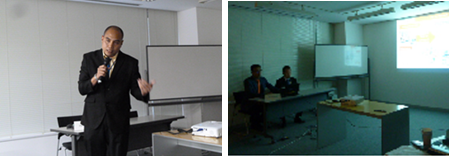
Presentations of Country Report (Philippines & Thailand Cases)
